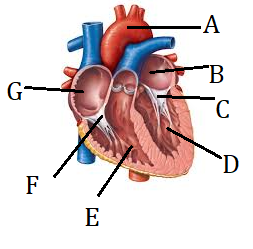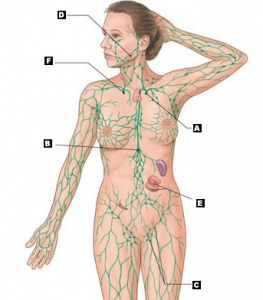BIO 1010 Questions
Chapters 13, 14, 15, 16
Each question is worth 2 points each= 40 points total.

- Identify all the labeled structure of the above heart image.
- Aorta. B. Left Atrium. C. Mitral Valve. D. Left Ventricle. E. Right Ventricle. F. Tricuspid Valve. G. Right Atrium.
- List all the function of blood.
Blood supplies oxygen to the cells and tissues of the body, as well as supplying them with nutrients such as amino and fatty acids, and glucose. Bloody also takes away waste materials from the cells and tissues, such as urea and carbon dioxide.
- Your patient presents with a hematocrit of less than 20% and a buffy coat of more than 30%. Is this a healthy or sick patient? If sick, explain why.
This patient is sick: the low hematocrit indicates anemia – a low red blood cell count, resulting from too little oxygen being transported to the cells in the body. The high buffy coat percentage indicates a higher number of white blood cells, suggesting infection.
- In the ABO blood group, what is the function of antibodies?
In the ABO blood group the function of antibodies is to fight any antigens (such as infectious viruses and bacteria) which enter the body.
- What is the difference in leukopenia and leukocytosis?
Leukocytosis is a disease in which more than normal numbers of white blood cells are present in the body. Leukopenia is a result of low counts of leukocytes. While Leukocytosis is usually due to an increase in neutrophils, Leukopenia is usually due to a decrease in neutrophils.
- Why do arteries, veins and capillaries have such different structures?
These organs have different structures depending on their function. Capillaries have only a single layer of cells, allowing oxygen and CO2 to pass through easily. Veins and Arteries have more layers of cells – muscle tissue and connective tissue – to help regulate the flow of blood as it moves through the body.
- Identify and briefly describe a specific type of valve disorder.
In a mitral valve prolapse, the mitral valve does not close properly after each beat of the heart, allowing blood to leak backward into the chamber.
- Identify and briefly describe a specific type of cardiac dysrhythmia.
Atrial Fibrillation is a type of dysrhythmia characterized by an irregularly fast heartbeat, which occurs as a result of the heart’s electrical signal starting from the incorrect location in the heart.
- Identify and briefly describe a specific type of blood vessel disorder.
Atherosclerosis occurs when the arteries supplying blood to the heart become clogged with plaque from fat and cholesterol. It can lead to chest pain or even a heart attack.
- Briefly describe how diuretics affect hypertension.
Diuretics lower blood-pressure by flushing excess salt and fluid out of the blood through the urine. They therefore help treat hypertension by lowering blood-pressure.
- Identify and briefly describe one specific type of shock.
Cardiogenic shock is shock that occurs when the heart becomes so damaged that it cannot no longer supply enough blood to the body. It is often but not always a result of a heart attack.

- Identify all the labeled parts of the lymphatic system in the above image.
- Subclavian Veins. B. Thoracic Duct. C. Inguinal Lymph Node. D. Tonsils. E. Small Intestine Lymphatic Tissue. F. Right Lymphatic Duct.
- What is lymph and where does it come from?
Lymph is the fluid that flows through the lymphatic system. It forms when tissue fluids are collected in lymph capillaries.
- Define lymphedema.
Lymphedema is swelling that occurs when the lymphatic system becomes blocked, causing fluid retention. It can occur as a result of damage to the lymph nodes.
- Hypothesize why you have clusters of lymph nodes on your neck/throat, (axillary) armpit regions and (inguinal) groin.
Lymph nodes are important to the immune system, so they might appear in these locations because these are common sites for bacteria and infection to enter the body.
- Why is the thymus important to immunity?
The thymus is important for immunity because it is the site in the body where white blood cells mature and become adapted to specific antigens.
- Identify and describe all the ways innate and adaptive immunity differ? (*Hint* look at table 16-1 in your eText).
Innate immunity is the immunity already present in the body. Adaptive immunity is immunity the body creates in response to exposure to a foreign antigen. Adaptive immunity is slower but more potent, and can work against non-microbial substances as well as microbial ones.
- How does a vaccine work?
A vaccine works by exposing the body’s adaptive immune system to a harmless dose of a specific antigen, so that it can produce appropriate antibodies.
- Where do T cells mature? Where do B cells mature?
Both of these types of cell mature in the body’s bone marrow.
- Define autoimmunity and identity an autoimmune disorder.
Autoimmunity is when the body’s immune system attacks its own cells instead of foreign invaders. Celiac disease is a type of autoimmune disease in which eating gluten causes the immune system to destroy the small intestine.